- Submitting a case study? Email CaseStudies@DigitalTrainingAcademy.com
- Booking a course? Email Tutors@DigitalTrainingAcademy.com or call +44 (0)20 7244 9661
- Apply for a training needs assessment
Digital marketing industry case study library
Browse case studies by topic
Case studies library
- Case studies
- - Advertising
- - Ecommerce
- - Healthcare and pharmaceutical
- - Mobile marketing
- - Search
- - Social media
- - Sport
- - Travel
- - Viral
- - YouTube
- All other case studies
- Daily digital marketing news
Training services
- In-company training
- Executive coaching
- Marketing courses
- Current participants
- Graduate services
- About us
- Case study library
Consultancy and research
Youth Marketing case studies: we currently have 76.
Any agency or media owner can submit case studies to our team and these 76 are the strongest we have received, with the most recent case studies at the top of this page. If you're interested in more digital marketing case studies then review our complete case study library. If you're interested in submitting case studies then email our case studies manager to find out more CaseStudies@DigitalTrainingAcademy.com.
<< Previous 1 2 3 4 Next >>
Social media case study- Beauty retailer Sephora mixes in-store, mobile and online to build brand love
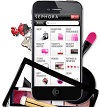
Looking for a retail brand who has made best use of digital media to enhance the shopping experience? Then look no further than Sephora. This US-based beauty retailer has been incredibly savvy at seamlessly integrating all the latest web, social and mobile media platforms with the physical store to drive customer engagement and sales. They have cleverly leveraged social media – through Facebook, Twitter and more recently Pinterest – to build an on-going dialogue with a large and loyal online fan-base of beauty lovers. They have developed mobile, tablet and in-store digital media platforms to interweave the online / offline shopping journey.
27/06/2012 | Full story...
YouTube advertising- Code Club school kids grill Internet pioneers

The founders of YouTube, Skype, Lastminute and even the world wide web face their toughest grilling yet in this humourous video from Code Club, a new UK initiative to try to get more kids learning to code. The video turns the idea of a startup pitch parade on its head, giving the reigns to a panel of kids, and the job of pitching to some of the biggest successes in technology today. The YouTube ad has so far racked up more than half a million views.
More on this Case Study:
| Media: YouTube, Viral, Video | Country: India | Sector: Film | Objective: Build brand equity| Format: Viral Video »
27/06/2012 | Full story...
Video viral- Nike Euro 2012 ad gets 9 million views in 3 days

Nike’s football tournament ads have become something of an event in themselves in recent years, but the new “My Time is Now” YouTube ad could be their most successful online venture yet. The YouTube video hit 3 million views in only three days and features an all-star cast of footballers. The video release coincided with the beginning of the European Championships. At time of writing, the has racked over 14 million YouTube views and 80,000 ‘likes’.
More on this Case Study:
| Media: YouTube, Viral, Video | Country: India | Sector: Film | Objective: Build brand equity| Format: Viral Video »
27/06/2012 | Full story...
Case study: Search engine marketing strategy as Converse creates entertainment from Google

This case study from Conserve has to be the most innovative approach to search engine marketing that we have ever seen. In order to connect with their youth audience in a highly targeted and personal way Converse exploited the search engines results page by cleverly bidding on long tail keyphrases that they could assume were teenager generated.
This enabled them to own paid search advertising spaces (otherwise unexploited) to start a conversation and capture response (at a very low cost) from their target audience. With this simple tactic in place they generated numerous low cost microsites that collectively captured the imagination of their audience.
More on the case study:
Brand: Converse | Media: Search and websites | Country: USA / Global | Agency: Anomaly | Sector: Clothing - Footwear | Objective: Build brand equity, create relevant entertainment experiences | Format: Search engine marketing strategy that combines search with entertainment and microsites
25/05/2012 | Full story...
Video viral case study: P&G’s ‘Olympic Moms’ ad gets over 4m YouTube views

Procter & Gamble embarked on the company’s biggest campaign in its 174 year history, using its Olympic sponsor status to push an emotive message celebrating mothers worldwide (a key demographic for the FMCG brand). P&G’s ‘Best Job’ video has taken off since launching April 17. More than 4m people watched the video on the main site, which has been seeded in different languages to appeal to different territories.
More on this Case Study:
Procter & Gamble | Media: YouTube, Viral, Video | Country: Global | Sector: FMCG personal care | Objective: Build brand equity, drive trial | Format: Viral Video »
24/05/2012 | Full story...
Social media marketing- Unilever uses Facebook vouchers for Marmite cereal bar giveaway
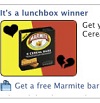
In early 2010, Unilever launched a campaign on Facebook to distribute samples of its new Marmite Cereal Bar and to drive awareness of the new product. This case study shows how the brand used the Facebook Ad Units format to create buzz, generating 22m impressions and distributing 33,000 samples to its target audience of mums and young adults.
More on this Case study …
Brand: Unilever Marmite |Media: Facebook | Country: UK |Sector: Food & Beverages| Agency: Mindshare | Format: Facebook Ad Unit
14/05/2012 | Full story...
‘Peephole’ Axe campaign mixes QR codes with Facebook to drive brand engagement

This risqué ‘Peephole’ campaign from men’s deodorant brand Axe made innovative use of QR codes. The ad targeted its demographic of young men with a ‘hot’ video that suddenly stops, prompting viewers to continue the experience at the brand’s Facebook page. Once on the social networking site, users could unblock hotter and more daring videos by sharing the experiences with their friends. The action kept getting hotter in the videos, all leading to one common message: STOP LURKING, START MATING. Experience the AXE Effect. A reminder that to get into the action, you need AXE.
The campaign worked by making smart use of QR codes, video content, Facebook Pages and consumer insight. The results were 14% of the target audience watched the videos daily. 33% increase in social interaction with the brand. 52 % increase in post views and feedback (engagement) on Facebook.
More on this Case study …
Brand: Axe |Media: OOH, Facebook videos | Country: US |Sector: FMCG | Agency: DDB Puerto Rico, Guaynabo| Format: Facebook Page videos
Social media case study Axe Facebok campaign | YouTube Viral Video Peephole advert
09/05/2012
Top India video virals- Kolaveri Di
The song 'Kolaveri Di' used to promote the movie ‘3’ has become one of the internet viral sensations of last year, setting new benchmarks and trends for virals. The video has generated an astonishing 56 million views on YouTube.
More on this Case Study:
| Media: YouTube, Viral, Video | Country: India | Sector: Film | Objective: Build brand equity| Format: Viral Video »
08/05/2012 | Full story...
Top India video virals- Virgin Mobile
These ads for Virgin Mobile were launched on digital media only with the launch of IPL (cricket in 2010). The ads were distributed via a targeted email and social network campaign aiming to reach the core market of Young Indian males. The collection of ads have racked up over a million views.
More on this Case Study:
| Media: YouTube, Viral, Video | Country: India | Sector: Film | Objective: Build brand equity| Format: Viral Video »
07/05/2012 | Full story...
Digital Vs TV spend: Cadbury's online video advertising gets 4 times more ROI than TV

Cadbury's "Chocolate Charmer" online advertising campaign provided ROI almost 4 times higher than their TV campaign. The chocolate brand ran a cross-media campaign for its Dairy Milk brand, covering TV, online ads and YouTube promoted videos. Despite only investing 7% of its budget in online, the brand saw the sector generate 20% of the sales. This case study from Gfk NOP highlights to growing power of online advertising in the marketing mix.
More on this Case study
More on this case study:
Brand: Cadbury’s | Media: YouTube, TV, Social Media | Agency: Fallon London | Country: UK | Sector: FMCG
06/03/2012 | Full story...
Case Study: How Coke Zone’s customer loyalty scheme became the top grocery brand site in the UK

Back in 2008, Coca-Cola was faced with a declining market share in the UK teen market. This case study reveals how the drinks giant linked on-pack point codes to an engaging Coke Zone rewards website, boosting customer loyalty and becoming the most visited UK grocery brand site in the process.
Since the scheme went live, its email offers mailshot enjoys an open rate of 49 percent and a click through rate of 71 percent. The Coke Zone site garners dwell time averages 9 minutes, and prize draw entries total 116,497. Coke Zone is now consistently the UK's no.1 Food & Drink brand website. Currently the site gets over 38 million Facebook fans and over 400,000 Twitter followers.
More on this case study:
Brand: Coca Cola | Media: interactive digital marketing | Country: UK | Sector: FMCG Drinks | Objective: engage the youth market | Agency: Carlson Marketing | Format: Multi-Channel Marketing
Digital Marketing Case Study | Coke Zone's holiday video
13/02/2012 | Full story...
The secret is out there: How Coca Cola used a multi-channel advertising campaign to engage the teen market

Many companies worry about how their brand is being talked about online as it is seems unpredictable and uncontrollable. This case study shows how Coca Cola encouraged conversations to happen about their brand with a multi-channeled digitally focused ad campaign full of relevant, engaging and viral content.
More on this case study:
Brand: Coca Cola | Media: interactive digital marketing | Country: US | Sector: FMCG Drinks | Objective: engage the youth market | Agency: Wieden+Kennedy | Format: multi-channel advertising
Digital Marketing Case Study Video
07/02/2012 | Full story...
How Sony pictures used rich media to create buzz for 3D film Smurfs
To promote the Smurfs film in Malaysia, Sony Pictures used interactive rich media ad formats to closely engage with the target audiences and generate high dwell rates. The campaign’s tone was fun and entertaining, to keep in line with the feel of the movie.
This case study shows how, with rich media advertising on MSN and MSN Messenger, Sony Pictures got viewers to engage with the brand on the website itself. Users spent and average of 146.36 sec on the banner and the average dwell rates of the campaign were 8.62%, which is above the benchmarks of Malaysia. The campaign was targeted toward the key audience of the movie- teens and young adults age 12-25 and parents with children age 5-12 years. The purpose of the campaign was to create viral buzz about the movie and drive ticket sales for the release of the movie.
More on this Case study …
Brand: Sony Pictures| Media: MSN Malaysia, MSN Windows Live Messenger | | Country: Malaysia | Sector: Entertainment |Agency: Universal McCann MY, Monster Interactive MY |Format: Rich Media Interactive 3D ads
Download the Case Study: Sony Pictures
24/10/2011
Case Study: French Connection - FCUK | Media: MSN | Country: UK | Sector: Clothing | Objective: Brand awareness, brand repositioning, buzz | Format: In-game advertising
![]() In-game advertising on the Massive network provided the genuine buzz needed to establish FCUK as a leading fashion brand for young men. Previously used as a campaign slogan by clothing brand French Connection, the big rises in awareness and word-of-mouth recommendation delivered by the campaign helped to establish FCUK as a brand in its own right.
In-game advertising on the Massive network provided the genuine buzz needed to establish FCUK as a leading fashion brand for young men. Previously used as a campaign slogan by clothing brand French Connection, the big rises in awareness and word-of-mouth recommendation delivered by the campaign helped to establish FCUK as a brand in its own right.
Download the MSN case studies compendium
26/04/2010
Case Study: Gjensidige | Media: MSN | Country: Norway | Sector: Finance | Objectives: Engagement, cut-through | Format: Online advertising, rich media,
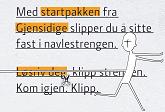 An innovative, personalisable avatar brought the benefits of financial independence to life for banking and insurance company Gjensidige. Deployed to engage young adults, the avatar swung into action through expanding banner ads, tying up new levels of engagement for a target audience that is highly resistant to the insurance category.
An innovative, personalisable avatar brought the benefits of financial independence to life for banking and insurance company Gjensidige. Deployed to engage young adults, the avatar swung into action through expanding banner ads, tying up new levels of engagement for a target audience that is highly resistant to the insurance category.
Download the MSN case studies compendium
26/04/2010
Case Study: Maybank | Media: MSN | Country: Malaysia | Sector: Finance | Objectives: Brand positioning, engagement | Format: Interactive media
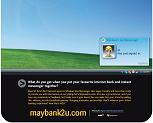 When Malaysia’s oldest banking institution wanted to engage a tech-savvy youth audience, it was time to call in Agent M, Asia’s first Windows Live Messenger financial ‘bot. His mission: to position Maybank as a youthful and progressive bank, solve banking problems instantly, and create new levels of engagement with young consumers.
When Malaysia’s oldest banking institution wanted to engage a tech-savvy youth audience, it was time to call in Agent M, Asia’s first Windows Live Messenger financial ‘bot. His mission: to position Maybank as a youthful and progressive bank, solve banking problems instantly, and create new levels of engagement with young consumers.
Download the MSN case studies compendium
26/04/2010
Case Study: MMA | Media: MSN | Country: France | Sector: Financial services - Insurance | Objectives: Brand awareness, engagement, driving traffic, click-through | Format: Mobile marketing
 Mobile advertising provided French insurance company MMA with a highly personal platform for warning young French adults of the dangers of drink driving. An innovative range of mobile content, including virtual breath tests and designated driver generators, drove a 2 per cent clickthrough rate, and a ten-fold increase in traffic on MMA’s road safety mobile site.
Mobile advertising provided French insurance company MMA with a highly personal platform for warning young French adults of the dangers of drink driving. An innovative range of mobile content, including virtual breath tests and designated driver generators, drove a 2 per cent clickthrough rate, and a ten-fold increase in traffic on MMA’s road safety mobile site.
Download the MSN case studies compendium
26/04/2010
Case Study: Ford | Media: MSN | Country: Denmark | Sector: Automotive | Objective: Brand awareness, brand repositioning, purchase intent | Format: Social Media, Design
 A bold, content-driven campaign, in which young women auditioned to present Fashion TV online drove Ford’s image makeover and helped to position the Fiesta as Denmark’s next top auto model.
A bold, content-driven campaign, in which young women auditioned to present Fashion TV online drove Ford’s image makeover and helped to position the Fiesta as Denmark’s next top auto model.
Download the MSN case studies compendium
23/04/2010
Case study: Nivea For Men | Agency: TBWA, Pixelpusher | Technology: MediaMind | Sector: Pharmaceuticals | Objectives: Engagement, brand positioning, purchase intent | Format: Rich media & video
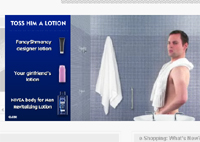 A neat use of video story-telling. The Nivea-for-men brand plays on the wider marketing proposition of personal grooming products for young male audiences and gives the viewer an option of a couple of different videos. The storyline of the actor when he has the women’s product is to transfer him to a shoe shop where he is amusingly out of place, while the right (male) lotion clearly does the trick and has his girlfriend march straight into the storyline. A simple way to build engagement and interactive humour into otherwise static, linear advertising.
A neat use of video story-telling. The Nivea-for-men brand plays on the wider marketing proposition of personal grooming products for young male audiences and gives the viewer an option of a couple of different videos. The storyline of the actor when he has the women’s product is to transfer him to a shoe shop where he is amusingly out of place, while the right (male) lotion clearly does the trick and has his girlfriend march straight into the storyline. A simple way to build engagement and interactive humour into otherwise static, linear advertising.
09/07/2009
Case study: Pepsi Dear Mr President | Agency: R/GA | Technology: MediaMind | Sector: FMCG | Objective: Brand awareness, brand positiong, purchase intent, engagement | Format: Rich media, social media, microsite & video
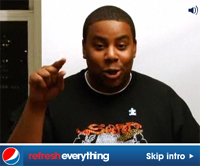 The goals for Pepsi were to bring awareness to their updated brand and logo, re-establish Pepsi’s position as a youthful challenger brand and tap into the iconic “change” social/political movement of the Obama election. They also wanted to foster brand community through 2-way communication with customers and chose the web and a social marketing model as the way to achieve this. Their ‘Refresh Everything’ message was a natural fit with Obama’s drive for change in politics and social values, and the campaign harnessed video content, social media and digital marketing in innovative ways to reach the millennial generation. The model centered around an open letter to Barack Obama and saw consumers recording their webcam messages directly from a video banner. This got them not only interacting with the banner, but actually creating content and pushing it back to the brand.
The goals for Pepsi were to bring awareness to their updated brand and logo, re-establish Pepsi’s position as a youthful challenger brand and tap into the iconic “change” social/political movement of the Obama election. They also wanted to foster brand community through 2-way communication with customers and chose the web and a social marketing model as the way to achieve this. Their ‘Refresh Everything’ message was a natural fit with Obama’s drive for change in politics and social values, and the campaign harnessed video content, social media and digital marketing in innovative ways to reach the millennial generation. The model centered around an open letter to Barack Obama and saw consumers recording their webcam messages directly from a video banner. This got them not only interacting with the banner, but actually creating content and pushing it back to the brand.
Download the case study: Pepsi Dear Mr President | View campaign creative
09/07/2009
Case study: Johnson & Johnson | Sector: Pharmaceutical | Objectives: Brand awareness, brand positioning, traffic generation | Format: Social media, branded content, microsite
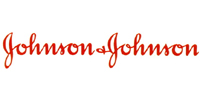 Johnson & Johnson Consumer B.V. (JJCBV) wanted to boost awareness of its o.b. tampon brand among young women in the Netherlands. Because the vast majority of Dutch women aged between 14 and 18 use Windows Live Messenger, the company worked with Microsoft Advertising to create a Personal Expression; a collection of interactive content used in the application. The hugely successful campaign increased brand usage by six percent among the target audience.
Johnson & Johnson Consumer B.V. (JJCBV) wanted to boost awareness of its o.b. tampon brand among young women in the Netherlands. Because the vast majority of Dutch women aged between 14 and 18 use Windows Live Messenger, the company worked with Microsoft Advertising to create a Personal Expression; a collection of interactive content used in the application. The hugely successful campaign increased brand usage by six percent among the target audience.
24/06/2009
Case study: Coca-Cola Zero & Nokia | Sector: FMCG | Format: Mobile
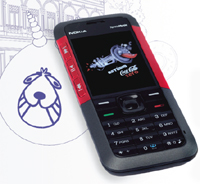 Coca-Cola Zero offers Coca-Cola taste with zero calories. Brazil has become one of its most important markets, and Coke Zero was looking for ways to reinforce its position as a leading low-calorie soft drink. To extend its relationship with young audiences it launched Coca-Cola Zero Studio, a project that fuses different types of music together. Two Brazilian artists recorded a show mixing their musical styles in association with a major music broadcaster, so Coca-Cola was seeking a way to share this content with consumers, and raise awareness of the recently launched Coca-Cola Zero brand.
Coca-Cola Zero offers Coca-Cola taste with zero calories. Brazil has become one of its most important markets, and Coke Zero was looking for ways to reinforce its position as a leading low-calorie soft drink. To extend its relationship with young audiences it launched Coca-Cola Zero Studio, a project that fuses different types of music together. Two Brazilian artists recorded a show mixing their musical styles in association with a major music broadcaster, so Coca-Cola was seeking a way to share this content with consumers, and raise awareness of the recently launched Coca-Cola Zero brand.
Download Nokia Coke Zero case study
01/05/2009
Case study: Skittles | Sector: FMCG | Format: Social media on Facebook
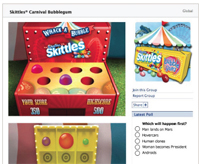 Skittles wanted to introduce and raise brand awareness for its new Carnival Gum confectionery product to teenagers and young adults on Facebook.
Skittles wanted to introduce and raise brand awareness for its new Carnival Gum confectionery product to teenagers and young adults on Facebook.
Skittles leveraged Facebook’s integrated advertising platform to build brand awareness for the new Carnival Gum using a combination of Virtual Gifts, Sponsored Stories and the custom Skittles Carnival Gum Sponsored Group branded destination.
Download Skittles Facebook case study
26/02/2009
Case study: Talk to Frank | Agency: Profero | Sector: Health information | Format: Web graphical formats
 When the UK government’s Central Office of Information commissioned the online elements of their health education campaigns to teach children about the dangers of drugs, they used a sophisticated mix of web formats to encourage interaction and solicit greater involvement. The ‘Talk to Frank’ campaign integrates the web, television, leaflets and face-to-face marketing activities to provide young people with access to detailed information about the specific risks of different drugs. This multi award-winning campaign included placements of banners and skyscrapers that encouraged viewers to take icons from one to the other in order to trigger an action: they could take the image of a drug from the banner to the brand character in the skyscraper and then see how it affected him. The activity delivered the message of the campaign without demanding a click through and as well as the visible skyscraper and banner formats included a rich media layer over the page.
When the UK government’s Central Office of Information commissioned the online elements of their health education campaigns to teach children about the dangers of drugs, they used a sophisticated mix of web formats to encourage interaction and solicit greater involvement. The ‘Talk to Frank’ campaign integrates the web, television, leaflets and face-to-face marketing activities to provide young people with access to detailed information about the specific risks of different drugs. This multi award-winning campaign included placements of banners and skyscrapers that encouraged viewers to take icons from one to the other in order to trigger an action: they could take the image of a drug from the banner to the brand character in the skyscraper and then see how it affected him. The activity delivered the message of the campaign without demanding a click through and as well as the visible skyscraper and banner formats included a rich media layer over the page.
Talk to Frank | Ask your Tutors for more insights | Submit your own case studies
16/04/2008
Case study: ArmyOnEverest.mod.uk | Agency: FitchLive | Sector: Army recruitment | Format : Content creation and event amplification
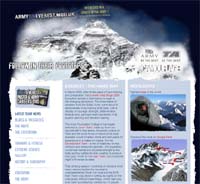 When the Army planned their assault on the West Ridge of Everest in 2006, there was an opportunity to engage young potential recruits by letting that story be told. Climbed only once in 30 years, only one group had ever made it to the top. PCIFitch were supplying the raw materials from the field back into the mainstream media as well as the web. The intention was to touch audiences through streams on the web, podcast downloads, iTunes and the broadest range of touchpoints. Over a million viewers enjoyed streamed content, blogs were posted to the site from the mountain and to feed into the recruitment processes, schools were targeted with lesson plans created for teachers and games for their students. Integration included downloadable posters and images, text alerts and more than a dozen different channels. The campaign went on to win the “Best digital campaign of 2006” at the Campaign awards. When we interviewed Peter Cowie, Managing partner at FitchLive who were behind the work, said “great work comes from the chemistry of the teams working together. The effect of the campaign included attracting 1m people, 30,000 of whom claimed they were ‘interested’ in joining the army. 3,500 are likely to be recruited as a direct result of the campaign”. For Peter it’s clear that “the future of advertising is about using all of these new channels together”.
When the Army planned their assault on the West Ridge of Everest in 2006, there was an opportunity to engage young potential recruits by letting that story be told. Climbed only once in 30 years, only one group had ever made it to the top. PCIFitch were supplying the raw materials from the field back into the mainstream media as well as the web. The intention was to touch audiences through streams on the web, podcast downloads, iTunes and the broadest range of touchpoints. Over a million viewers enjoyed streamed content, blogs were posted to the site from the mountain and to feed into the recruitment processes, schools were targeted with lesson plans created for teachers and games for their students. Integration included downloadable posters and images, text alerts and more than a dozen different channels. The campaign went on to win the “Best digital campaign of 2006” at the Campaign awards. When we interviewed Peter Cowie, Managing partner at FitchLive who were behind the work, said “great work comes from the chemistry of the teams working together. The effect of the campaign included attracting 1m people, 30,000 of whom claimed they were ‘interested’ in joining the army. 3,500 are likely to be recruited as a direct result of the campaign”. For Peter it’s clear that “the future of advertising is about using all of these new channels together”.
15/11/2007
Further youth marketing case studies
<< Previous 1 2 3 4 Next >>
Case study topics
- 1upSearch
- 20th Century Fox
- 3
- AA
- Adidas
- advertising
- advertising creative
- advertising spend
- Africa
- AIS
- AKQA
- All Nippon Airways
- analytics
- Android
- apps
- Argentina
- Army
- Asda
- Asia
- Audible
- augmented reality
- Australia
- Autobytel
- automotive
- Avis
- Axe
- banners
- Bayer Healthcare
- BBC
- behavioural targeting
- Belgium
- Ben and Jerrys
- Betfair
- Big Picture
- Blendtec
- Blink TV
- blogging
- BMW
- Bookstart
- brand awareness
- brand equity and positioning
- Brandcast Media
- Brazil
- British Airways
- British Gas
- Bruno
- Burberry
- Burger King
- Buzzfeed
- Cadburys
- Cambria Automobiles
- Canada
- Cannes Lions
- Cannon
- Carling
- Carlson
- CBI
- celebrity marketing
- Centrica
- Channel 4
- charity
- Chemistry UK
- Chile
- China
- click through
- clothing
- Coca Cola
- Colgate
- Columbia
- Compass Interactive
- consumer electronics
- consumer insight
- content marketing
- Creative Lynx
- Crispin Porter and Bogusky
- CRM eCRM and email marketing
- Croatia
- cut through
- Cyprus
- Denmark
- design
- Diageo
- digital companies
- Digital Intelligence
- digital marketing
- Digital Marketing Case Study
- Digital Training Academy
- digital trends
- direct response
- directory
- Dove
- driving traffic
- DTI
- Dynamic Logic
- easyJet
- ecommerce
- eDetail
- education
- EE
- Egypt
- EMEA
- Emirates
- energy
- engagement
- entertainment
- environment
- Europe
- experiential marketing
- Festival
- Fiat
- film
- finance
- Finland
- Fish4jobs
- FitchLive
- Flickr
- FMCG digital marketing
- Ford
- France
- French Connection
- Friends of the Earth
- FuturAd
- g8wave
- gaming and gamification
- Germany
- Gjensidige
- global
- glue London
- Golden Pages
- Google AdWords
- government
- Greece
- Greenlight
- GSK
- H and M clothing
- Habitat
- Halesway
- Handbag
- healthcare and pharmaceutical
- Heineken
- Heinz
- Hewlett Packard
- Hong Kong
- Hong Kong Tourist Board
- Incentivated
- increasing conversion
- India
- Indonesia
- ING
- Inside Mobile
- insurance
- integrated marketing
- interactive media
- Israel
- Italy
- Jaguar
- Janssen Cilag
- Japan
- Johnhson and Johnson
- Johnnie Walker
- JVST
- KDDI
- Kelloggs
- KFC
- Kimberly Clark
- Kleenex
- Kraft
- Kwik Fit
- Lacta
- Langland
- lead generation
- LEGO
- Levis Jeans
- LG
- Life chats
- Lionsgate
- Lipton
- local
- LOreal
- luxury
- Lycos
- M and C Saatchi
- MacMillan
- magazine
- Malaysia
- marketing
- Marketing Evolution
- marketing fails
- Mars
- Mazda
- McDonalds
- Mediacom
- MediaMInd
- Mentos
- Mexico
- Microsoft
- Middle East
- MMA
- mobile marketing
- Monarch
- Mondelez
- Motorola
- MSN
- music
- Nestle
- Netherlands
- NetSupport
- Netthink ES
- New Zealand
- Nike
- Nivea
- Nokia
- Norway
- Norwich and Peterborough
- Nutella
- OgilvyOne
- Oi Media
- online advertising
- online forum
- online media
- online radio
- Oodle
- Oracle
- Oreos
- Outdoor
- Palm
- pay per click advertising
- Pedigree
- Pepsi
- Periscope
- Philippines
- Pixelpusher
- Plumbworld
- podcasting
- Poland
- portal
- Portugal
- Procter and Gamble
- Profero
- publishing strategy
- purchase intent
- Qatar Airways
- QR codes
- R GA
- Radisson Edwardian Hotels
- Random42
- Reckitt Benkiser
- recruitment
- RedEye
- Reebok
- reputation management
- retail
- Revels
- rich media
- Rocksound
- Romania
- Royal Marines
- Russia
- Saatchi and Saatchi
- Sainsburys
- Samsung
- Saw V
- Schering Plough
- Schroders
- search
- search engine optimisation
- security
- Sephora
- Shell
- Singapore
- Skive Creative
- Skype
- Slovakia
- SnapChat
- Snickers
- social media
- Sonaa
- Sony
- South Africa
- South America
- South Korea
- Spain
- sport
- Sprite
- STA Travel
- Starbucks
- strategy
- Stride
- Sweden
- Switzerland
- Sympatico
- Taglab
- Taiwan
- Talk Talk
- Talk to Frank
- targeting
- TBWA
- technology
- technology and software
- Telecommunications
- Television
- Thailand
- The Body Shop
- Tourism New Zealand
- Toyota
- traffic driving
- Transport for London
- travel and tourism
- trend creation
- Tumblr
- Turkey
- TVL
- UAE
- UK
- Unilever
- Universal Pictures
- Universal Studios
- USA
- uSwitch
- Vaseline
- Vauxhall
- VeriSign
- video
- Vietnam
- Vine
- viral
- Virgin
- Visa
- Vodafone
- Volkswagen
- Volvo
- Warner Breaks
- Warner Bros
- Warner Music
- Webcredible
- William Hill
- Windows
- Windows Live Messenger
- Worth
- Yahoo
- youth marketing
- YouTube